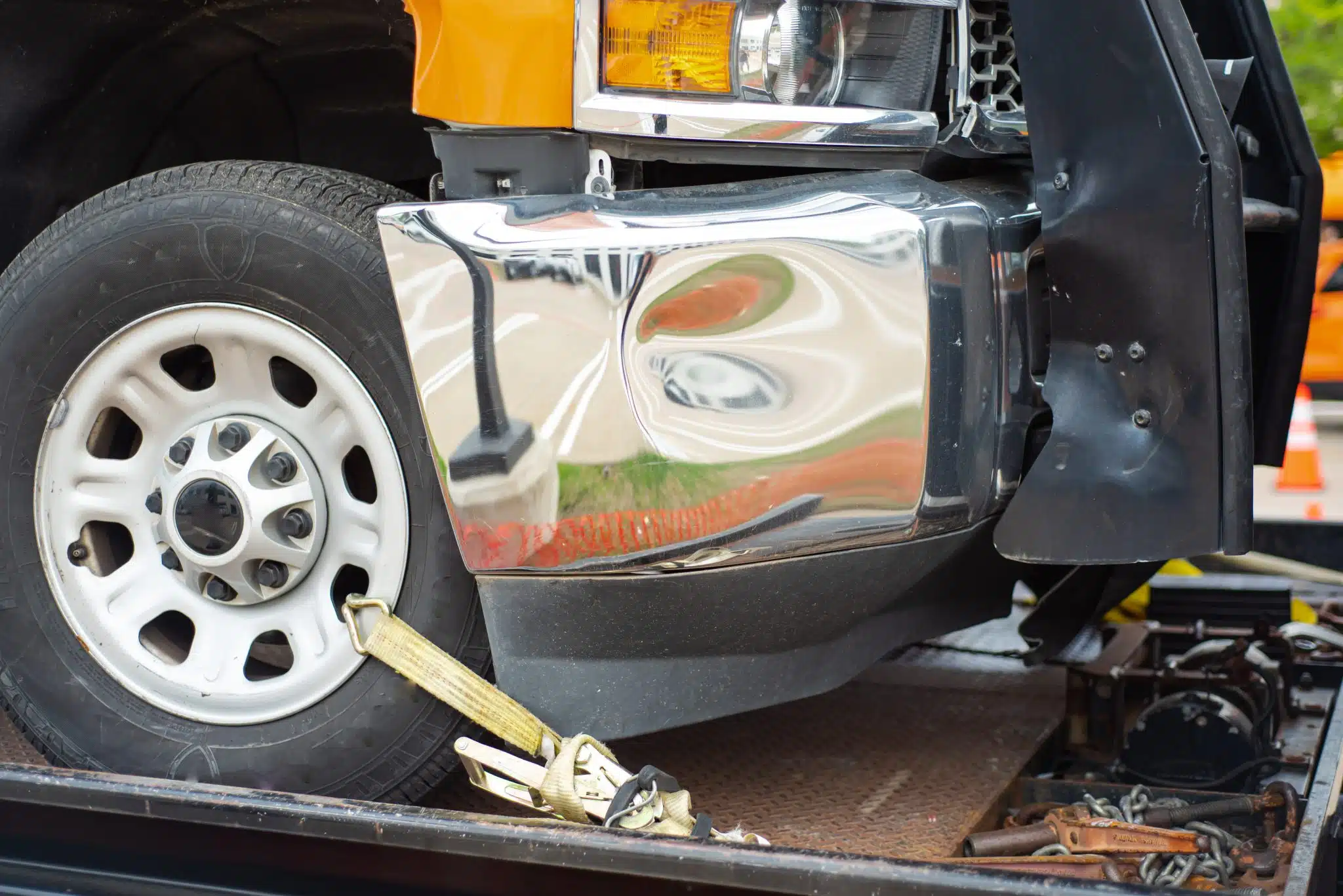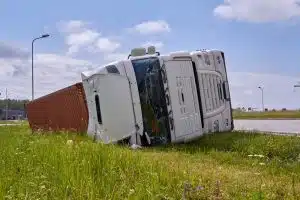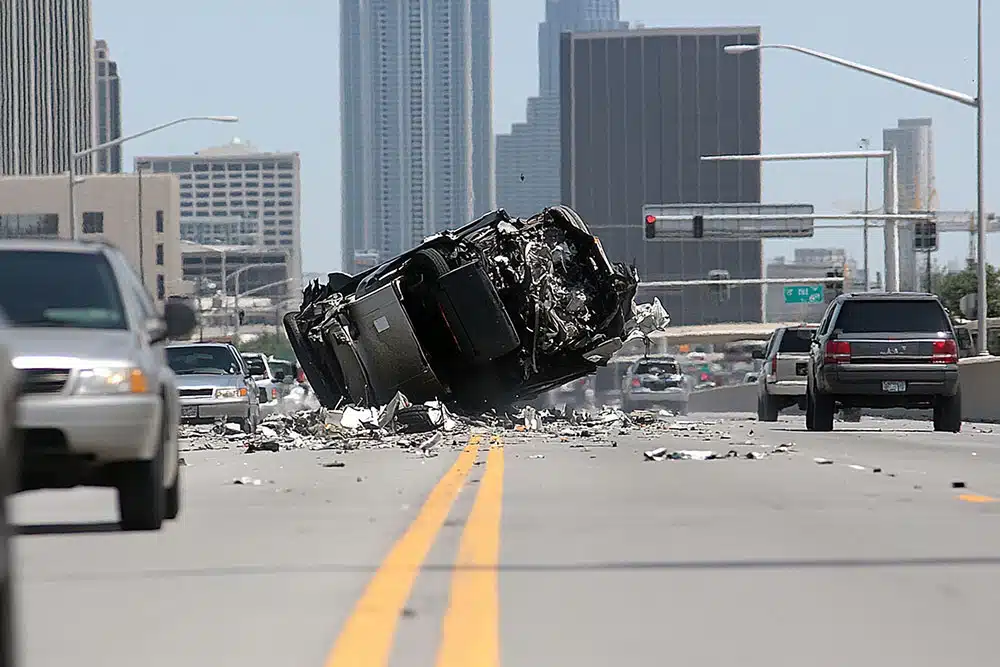
What Causes Flatbed Truck Accidents?
Improper Cargo Securement
When a flatbed truck’s load isn’t properly secured, the resulting instability can create accidents such as:
- Cargo spills: Improperly tied-down items can fall into traffic, leading to collisions or abrupt maneuvers by other drivers that cause further crashes.
- Rollover accidents: Unbalanced or overloaded cargo raises the truck’s center of gravity, increasing the risk of tipping during sharp turns or sudden stops.
- Multi-vehicle pileups: Shifting loads that destabilize the truck can trigger chain reactions on busy roadways.
Rigorous compliance with federal regulations ensures cargo is properly secured, reducing these risks. Failure to meet these standards often reflects negligence, making liability a key focus in personal injury claims.
Driver-Related Errors
Mistakes or lapses in judgment by flatbed truck drivers frequently result in dangerous scenarios, such as these accidents:
- Rear-end collisions: Distracted driving or delayed reactions due to fatigue can prevent timely braking, causing crashes with vehicles ahead.
- Jackknife incidents: Speeding or sudden braking can cause the trailer to swing sideways, leading to a loss of control.
- Underride accidents: A lack of focus or awareness may leave smaller vehicles exposed to sliding under the flatbed.
When drivers or their employers neglect these responsibilities, the resulting accidents are often legally actionable.
Mechanical Failures
Flatbed trucks require diligent maintenance to avoid dangerous mechanical issues that can lead to accidents such as these:
- Brake failures: Overloading or poor maintenance can cause brakes to malfunction, increasing the likelihood of collisions.
- Tire blowouts: Worn or overinflated tires may burst under pressure, leading to loss of control or lane departure crashes.
- Trailer detachment: Faulty hitches can separate flatbeds from trucks, potentially causing catastrophic collisions.
Routine inspections and timely repairs are non-negotiable for safe trucking operations. Evidence of neglected maintenance often supports negligence claims, providing an avenue for injured parties to seek compensation.
Loading and Unloading Errors
Even the processes of loading and unloading cargo can create hazards when mishandled, leading to accidents like these during transport or preparation:
- Falling objects: Incorrect use of cranes or forklifts during loading can dislodge heavy items, creating safety risks for workers or drivers below.
- Rollover risks: Poor weight distribution during loading increases instability, making the flatbed prone to tipping on turns.
Employers must enforce safety protocols to reduce these risks. Cutting corners, often to save time or costs, can demonstrate negligence and open the door for legal recourse.
Environmental and Weather Factors
Adverse weather conditions increase the danger of flatbed truck operations, often contributing to the following accidents:
- Skidding collisions: Ice, rain, or snow make roads slippery, leading to reduced traction and crashes.
- Rollover incidents: Strong crosswinds disproportionately impact flatbeds carrying tall, top-heavy loads.
While weather is uncontrollable, adapting to conditions is an expected responsibility. Accidents caused by a driver’s failure to adjust their handling under challenging conditions can also point to negligence.
Where Do Flatbed Truck Collisions Occur Most Often?
Flatbed truck collisions can happen anywhere but are more prevalent in certain locations due to risk factors like traffic density, road conditions, and cargo handling challenges. Common locations where these accidents occur include:
- Highways and interstates: Speeding, heavy traffic, and sudden braking often lead to cargo spills, jackknifes, or multi-vehicle pileups.
- Construction zones: Flatbed trucks frequently transport heavy loads like steel beams or machinery to building sites, where tight spaces and driver miscalculations can result in collisions.
- Urban areas: Narrow streets, busy intersections, and pedestrian traffic increase the likelihood of accidents involving cyclists or smaller vehicles.
- Rural roads: Poor lighting, uneven surfaces, and sharp turns create hazards for flatbed trucks, particularly those carrying oversized loads.
- Loading and unloading zones: Accidents occur during maneuvers in tight spaces or when cargo isn’t properly secured after loading.
It doesn’t matter where these accidents occur or how seemingly minor they may appear. Delayed injuries, unexpected claim challenges, or overlooked liabilities make seeking guidance from an experienced personal injury lawyer essential to recovering fair compensation.
Common Types of Flatbed Truck Accident Injuries That May Be Eligible for Compensation
Traumatic Brain Injuries (TBI)
Traumatic brain injuries frequently occur in rollover accidents or underride collisions, where sudden impact or heavy cargo causes head trauma. TBIs can range from concussions to permanent cognitive impairment, often requiring costly medical interventions.
- Average upfront costs: Emergency care and initial treatment may cost between $20,000 and $100,000.
- Lifetime costs: Severe cases involving lifelong care and therapy can exceed $1 million.
Recovering compensation for TBIs often involves proving the accident’s impact on earning potential and quality of life, requiring meticulous documentation.
Spinal Cord Injuries
Spinal cord injuries typically result from high-impact crashes, such as jackknife incidents or load spills. These injuries can cause partial or complete paralysis, drastically altering a victim’s life.
- Average upfront costs: Immediate costs, including surgeries and emergency hospitalization, range from $50,000 to $150,000.
- Lifetime costs: Long-term care, equipment like wheelchairs, and home modifications can surpass $2 million.
Qualifying for compensation may require showing how the injury meets serious thresholds, such as permanent disability or the loss of bodily function.
Fractures and Broken Bones
Flatbed crashes often involve falling cargo or side impacts, leading to broken bones and fractures. These injuries, though common, can disrupt the ability to work while requiring costly surgical repair.
- Average treatment costs: Costs per fracture, including surgery and rehabilitation, range from $10,000 to $50,000.
While these injuries may seem straightforward, demonstrating their financial and lifestyle impact is critical to pursuing fair compensation.
Burns and Disfigurement
Cargo fires or vehicle explosions in severe flatbed truck crashes can lead to burns and scarring, requiring extensive medical treatment.
- Upfront costs: Surgeries, burn unit care, and skin grafting procedures can cost $200,000 to $1 million.
- Long-term expenses: Additional treatments such as cosmetic surgery or therapy add to these substantial costs.
Burn injuries often qualify for non-economic damages related to emotional trauma and loss of enjoyment of life, but these must be substantiated through evidence.
Internal Injuries and Organ Damage
Blunt force trauma from underride crashes or falling objects can lead to internal bleeding or organ damage. These injuries are often life-threatening and require immediate intervention.
- Treatment costs: Depending on the severity, initial surgery and critical care may cost up to $200,000 or more.
Proving the lasting impact of such injuries requires comprehensive medical evidence, making legal representation invaluable.
How a Lawyer Can Help With Compensation Claims
Recovering compensation for injuries sustained in flatbed truck accidents often requires more than filing an insurance claim. Skilled legal counsel can assist by doing the following:
- Demonstrating negligence: Lawyers investigate accident causes, from improper cargo securement to inadequate maintenance, to demonstrate liability.
- Assistance gathering evidence: This includes medical records, police reports, witness statements, and expert opinions needed to support claims.
- Calculating full damages: To pursue comprehensive compensation, an attorney evaluates both economic losses, like medical bills, and non-economic impacts, such as pain and suffering.
- Countering insurance tactics: Trucking companies and insurers often aim to minimize payouts. Legal professionals negotiate or litigate to advocate for what clients are truly owed.
- Meeting legal thresholds: Whether it’s serious injury qualifications or statutory deadlines, lawyers help you make sure your claim is prepared and filed correctly.
The right legal support uncovers the accountable parties and builds a path toward meaningful compensation. Are you ready to explore how these injuries could shape your legal options? Contact a trusted attorney who can help demonstrate the visible and hidden costs of your recovery.
When Should I Contact a Personal Injury Lawyer After a Flatbed Truck Accident?
Contacting a truck accident injury lawyer right after your accident is often the ideal time to explore your rights and legal options. Other scenarios that may imply the need for legal assistance include but are not limited to:
- When determining fault is unclear or disputed: If multiple parties, such as the driver, trucking company, or cargo loaders, may share responsibility for the accident, a lawyer can help untangle the complex liability issues.
- When your injuries are severe or life-altering: Catastrophic injuries like spinal cord damage or traumatic brain injuries often exceed the coverage limits of basic insurance, requiring legal help to pursue full compensation.
- When dealing with uncooperative insurance companies: Insurers may delay payouts, offer low settlements, or deny valid claims. Legal representation fights back against unfair tactics that could diminish or deny your claim.
- When federal or state regulations are likely involved: Violations of cargo securement standards or driver safety rules may necessitate a thorough legal investigation.
- When wage or earning capability is impacted: Loss of work wages or reduced earning potential due to injury often requires precise calculations, which attorneys handle effectively.
- When evidence needs to be preserved: Lawyers can issue legal holds to prevent the destruction of maintenance logs, driver logs, or vehicle inspection records, which can be critical to your case.
- When serious injury thresholds must be met: Meeting legal injury standards often requires detailed medical documentation, which attorneys can help compile and present.
Flatbed truck accident cases are often time-sensitive, from preserving key evidence to meeting strict filing deadlines. Delaying legal assistance can weaken your claim and limit the compensation you may pursue.
Flatbed Truck Accident FAQs
What makes flatbed trucks more dangerous than other types of trucks?
Flatbed trucks lack enclosed cargo spaces, which increases the risk of items falling into traffic if improperly secured. This heightened danger often adds complexity to liability in legal cases.
Who can be held liable for a flatbed truck accident?
Liability in flatbed truck accidents can extend to the driver, trucking company, cargo loaders, or equipment manufacturers. Determining fault often involves careful investigation of maintenance records and cargo handling practices.
How can lost cargo from a flatbed truck impact a legal case?
Lost cargo can indicate improper securement, a violation of federal trucking regulations. This failure may be used as evidence to prove negligence in a personal injury claim.
Do I need evidence to file a claim after a flatbed truck accident?
Evidence like medical records, photos of the accident scene, and truck inspection logs are crucial for building a strong case. Legal guidance can help preserve vital evidence before it is lost.
What types of damages can be recovered in a flatbed truck accident case?
Injured parties may be able to pursue compensation for medical costs, lost wages, property damage, and pain and suffering. Proving these damages often requires detailed documentation and expert testimony, areas where legal support is invaluable.
Injured in a Flatbed Truck Accident? Contact The Rothenberg Law Firm For Comprehensive Legal Support.




